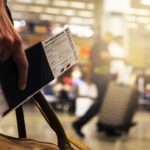Your passport is arguably the single most important item when you’re traveling internationally.
It’s your identity, your ticket across borders, and your lifeline in case of emergencies. Most travelers instinctively toss it into their carry-on, assuming that’s the safest, most logical spot. After all, it’s always within reach. But what if we told you that’s actually a big mistake?
In today’s world of crowded airports, strict security procedures, and increasing travel-related scams, putting your passport in your carry-on may be one of the riskiest decisions you make on your journey.
In this guide, we’ll explore why you should never store your passport in your carry-on, where you should keep it instead, and how to travel smarter and safer with this precious document.
1. Airports Are Prime Grounds for Theft
Let’s face it: airports are chaotic. In the rush to remove shoes, unload electronics, and empty pockets at security checkpoints, it’s easy to become distracted. Opportunistic thieves know this all too well.
Why It’s a Problem
- Carry-ons often sit unattended for short periods, especially during TSA screenings or when stowed in overhead bins.
- Thieves can snatch a passport from an outer pocket in seconds — especially in busy international terminals.
- If your bag is mistakenly swapped with someone else’s, your passport goes with it.
What to Do Instead
- Keep your passport on your body at all times, ideally in a zippered interior jacket pocket or a neck wallet under your clothes.
2. Overhead Bins Are Inaccessible in Emergencies
When you board a flight, you stow your carry-on in the overhead compartment. But in emergency situations — whether it’s turbulence, fire, or an unscheduled evacuation — you’re unlikely to have time to grab your bag.
Risk Factor
- If you’re forced to evacuate the plane without your carry-on, your passport is gone.
- It becomes even more dangerous if you’re stranded in a foreign country without identification.
Pro Tip
- Invest in a RFID-blocking travel wallet or belt to store your passport, boarding pass, and backup credit card close to your body — not overhead.
3. Gate Checks and Last-Minute Bag Transfers
Carry-ons can become checked baggage at the last moment if flights are overbooked or overhead bins are full. This means your passport could end up in the cargo hold — and possibly lost or delayed.
A Common Scenario:
You board a small commuter jet with limited bin space. A flight attendant insists you check your carry-on at the gate. You forget your passport is inside. Suddenly, it’s inaccessible until your final destination.
Solution
- Treat your passport like your phone or cash — keep it in your personal item or on your person.
4. Loss or Damage Risks During Transit
While carry-ons offer more protection than checked bags, they’re not immune to spills, squishing, or mishandling. Even well-padded compartments won’t stop a leaking water bottle or toiletry explosion.
Why It Matters
- A damaged passport (torn, soaked, or heavily bent) may be deemed invalid by immigration officials.
- A destroyed barcode or photo page can result in you being denied entry, fined, or detained.
Safer Option
- Store your passport in a protective, waterproof sleeve or pouch that you wear or store in a personal bag that stays with you at all times.
5. Airport Security Confiscation or Mishandling
TSA or airport security may inspect your carry-on during a routine scan. If your passport is in the bag:
- It may be mistakenly removed and not returned
- Left behind in a tray, where it can be stolen or forgotten
- Mixed up with other passengers’ belongings
Real-Life Example
Travelers have reported their passports being misplaced during random secondary screenings. Once separated, recovery becomes a bureaucratic nightmare, especially if it happens abroad.
6. You May Need Your Passport Before You Land
Not all passport use happens post-arrival. Some situations where you might need to access it mid-journey:
- During layovers in countries that require identification, even if you’re not exiting the airport
- In-flight ID checks on certain international flights
- If an emergency reroutes your flight, or there’s an unexpected stopover
If your passport is locked in the overhead bin or in a gate-checked carry-on, you won’t have immediate access to it.
7. You’re More Likely to Be Targeted as a Tourist
Tourists are frequently targeted because they’re often distracted and carrying valuables. When you constantly unzip your bag to pull out snacks, chargers, or headphones, you may be unintentionally revealing the location of your passport.
Pickpocket Alert
Professional pickpockets can spot travelers who store valuables in the same easy-access pocket every time. If they see you access your bag for a passport once, they can strike later without you noticing.
8. Lost Bag = Major Delays, Expenses, and Stress
Even if you’re flying with a well-reviewed airline, luggage — including carry-ons — gets lost, delayed, or misrouted more often than you think.
If Your Passport Is in There…
- You may miss your connecting flight or cruise.
- You might be denied boarding for return flights.
- Replacing a lost passport abroad can take days or even weeks, and hundreds of dollars.
9. Where Should You Store Your Passport Instead?
Here are safer alternatives to carry-on storage:
1. Neck Wallet or Money Belt
- Worn under your clothes and not easily accessible to thieves
- Some versions are RFID-blocking for added security
2. Travel Jacket with Hidden Pockets
- Keeps your passport close and secure, especially in airports
- Comfortable and discreet
3. Secure Crossbody or Anti-Theft Purse
- If worn correctly (across the body and zipped), it’s hard to snatch
- Some models have lockable zippers or steel-reinforced straps
4. Inside Personal Item
- A smaller bag that stays under the seat in front of you
- You’re less likely to be separated from it during the flight
10. Extra Passport Tips for Smart Travelers
Make Digital & Paper Copies
- Scan your passport and email it to yourself
- Keep a hard copy in your checked bag or hotel safe in case of emergency
Use a Waterproof Cover
- Protect it from spills, weather, or airport accidents
Know Where It Is at All Times
- Create a habit of checking your passport location before boarding, disembarking, or transferring between hotels.
Conclusion: Don’t Gamble with Your Most Important Travel Document
While it may seem harmless to toss your passport into your carry-on, it exposes you to theft, damage, delays, and worst-case scenarios that can derail your trip.
As a rule of thumb, treat your passport the same way you’d treat your cash, phone, or credit cards — valuable, essential, and always within reach.
By keeping your passport securely on your body and using travel-smart habits, you can significantly reduce the risk of passport loss and travel stress. When you’re halfway across the globe, peace of mind is priceless.










